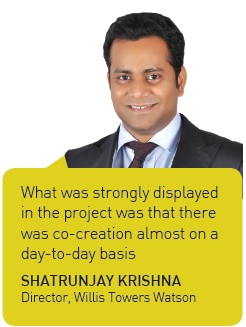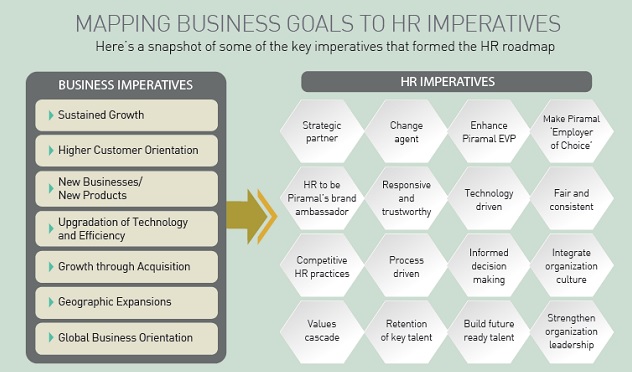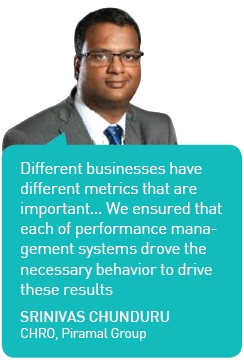Building a 'people-centric' organization: The Piramal Group story

For Piramal, it has been a journey from a manufacturing focused business to a knowledge intensive set of businesses. In 2010, Piramal Healthcare Ltd.’s domestic formulation business, generic-medicine unit in India was sold to Abbott Laboratories for Rs. 20,000 crores, making it one of the biggest deals in the Indian pharmaceutical industry and one of the biggest cash outs in India’s corporate history.
While continuing to stay in the healthcare business, the decision to invest in two new businesses was made to bring in growth for the future. Along with other businesses under its fold – from critical care, glass manufacturing, consumer products (like Lacto Calamine, Jungle Magic, and iPill) to consulting and analytics services for pharmaceutical companies, the Piramal Group entered into two new ventures. These were Piramal Fund Management - an integrated debt and equity platform for real estate and infrastructure projects; and Piramal Realty, a real estate development company, that currently holds 8 projects under development in the Mumbai metropolitan area.
For Piramal, a conglomerate of businesses, the challenges were associated with the lack of consistency in terms of people practices and systems, and for building a cohesive culture & mindset, unique Piramal culture and a talent pipeline. The Group’s ‘Vision 2020’ articulated the goal for the organization– to become 5 times bigger. It meant moving from a market capitalization of $4.5 billion to $20 billion, which demanded streamlining of people practices and systems across the group’s varied business lines. “There were many things that we wanted to do,” said Nandini Piramal, Executive Member on the board of the Piramal Group, “and it included creating better people systems, infusing a ‘one-Piramal’ mindset, and attracting and retaining high-quality talent” she added. While the driving vision and a change in the business mix pushed the need for a cohesive HR strategy, the company’s wake-up call came when an assessment of its talent pipeline revealed that it was not robust enough to drive the exponential growth plans of the business. This spurred a strong business case and created the buy-in required from business for the HR transformation journey – driving talent development and becoming an employer of choice, as well as transforming HR structure and efficiency.
Getting the basics right
In the first phase, the HR imperative was to create credible systems and processes within the function. Based on employee feedback, there were two focus areas which were identified: performance management and L&D. According to a survey, employees felt that there was a need for greater clarity and transparency when it came to performance management. And so the company began sharing information about the compensation structure and variable pay with its employees – including details about performance levels, bonus payout and the clauses involved in it. This step not only enabled awareness, it created transparency.
Performance management systems were also enhanced to drive business results which in turn necessitated the active participation of the group’s business leaders. “Different businesses have different metrics that are important. For example, in a pharmaceutical business, the economic value added (EVA) and return on capital employed (ROCE) are important. For a consumer products business, EVA is important and for financial services, other than ROCE, the quality of the assets is important” stated Srinivas Chunduru, Chief Human Resource Officer, Piramal Group. “We got together with business leaders and ensured that each of the performance management systems actually drove the necessary behavior to drive these results” he said. So it was not just about creating transparency, it was also about creating shareholder value.
For enhancing learning and development, the company instituted a Learning University that offered customized learning solutions to employees across the Group. “We started with six programs servicing 900 odd people, and now we have expanded the Learning University to deliver 45+ custom programs delivering over 10,000+ learning needs. The Learning University calendar is customized to each business and is derived from the business goals for the year.” Srinivas said. Since the Group had varied business lines, a one size fits all approach would not work. For example, a manufacturing unit would focus on productivity with six sigma standards and for the financial services business, it could be customer centricity.
The HR department also took on the challenge of planning their people management programs a year in advance. And when the deadlines were adhered to, it led to increased credibility of the function in the system. “By then, we had been in the transformation journey for about two and a half years. Since the basics were in place, we felt a need to align our HR strategy” Srinivas said.
Transformation agenda
Piramal Group’s partnership with Willis Towers Watson (WTW) began in 2013 with an employee engagement survey that covered 6,000 employees. This periodic listening exercise surveyed the different HR programs and assessed how satisfied employees are across employee type, job level, location etc.,
“What we heard from employees is that they wanted to know how HR can partner with them,” Srinivas said. Another key finding was to do with consistency. Since the company had a presence in multiple geographies, the processes and employee experience needed to be made consistent. The company also examined key data points from their previous employee engagement surveys and collected, for over two years, information about employee interests and the direction of individual businesses.

The primary data and secondary data bolstered the agenda to create a strong HR process across the business. And in the face of a dynamic marketplace and on-going business model change, there was a need to re-look at the infrastructure around which HR operated and the basic building blocks upon which HR processes were built. The company reached out to WTW to help them do this. Starting December 2014, the company in partnership with WTW began engaging with various stakeholders. They conducted detailed interviews with top management and set up focus group discussions with employees. The emphasis in these conversations was to cull out what the business required from HR, in order for it to become a true business partner. This exercise was followed by workshops which included both, HR and business leaders. These workshops were used as a sounding board to say ‘what is important and what can be achieved in the next two years’.
At the end of the 3 to 4-month long process, four strategic work streams were identified that formed the HR roadmap, the work streams were: HR Structure and Governance, Efficient HR, Employer of Choice and Talent Development. The work streams served as a framework to the many interventions that were to be undertaken. Describing the need for a framework Shatrunjay Krishna, Director at Willis Towers Watson said “you don’t just have a process; you make sure the process works well because you have the right framework. And so within each work stream, there is a lot going on”.

HR Structure and Governance: At the structure level, the group was a matrix organization with operations across geographies and centers of excellence, it was important that the business interacted in a regular and dynamic manner. The focus on streamlining routine work led to moving a few routine processes out of the HR function, with a dedicated team within shared services. A total of 14 HR processes were moved to the global shared services team.
The company also created a central sourcing team. While previously, recruitment happened at multiple levels, it was not the best in terms of the process. Members of this team had previously worked with executive search firms and specialized in sourcing.

Another aspect within this work stream was to do with ‘HR for HR’, in other words, the development of HR. To reflect on the opportunities, an HR meet called ‘Neev’ was organized. So far, there have been five meets in four years, wherein a specific theme was identified and a workgroup was formed. One of the things that the organization focused on was ‘how to have conversations with the business in a language that is understood by them?’ As part of the development exercise, an external partner was then identified to deliver training. And the trained participants were attached to projects that further distilled functional and behavioral competencies.
The governance framework had to be set for streamlining HR processes. As the company was getting ‘bigger, better and stronger’, it was important to bring about the right standards around governance frameworks so that the service experience was consistent, whether an employee was in India, US or the UK. “It was also important to find the balance so that HR was not overly interfering,” Vivek Nath, Managing Director, Willis Towers Watson said.
Efficient HR: The focus for the interventions in this work stream centered on service delivery – which involved asking questions such as ‘how many people does an HR person serve? What is the turnaround time? What is the quality of hire? What is the performance rating of people hired last year?’ While these are some of the parameters, the company is yet to institutionalize an automatic tracking process.
The organization also instituted a ‘Service Efficiency Team (SET)’, which is the equivalent of six sigma standards that are used at a manufacturing plant. The objective of the SET was to take a problem, create subprocesses and create a tracking mechanism. The group has 13 SET teams in HR, out of which six of them have reached level one, out of a possible four levels. “It could take about four to five years to reach the top most level” Srinivas said.
The organization has so far identified a partner for its HRMS implementation in a six-month long process that included a detailed review of a number of systems that also involved business leaders.
Employer of choice: The goal of this work stream was to attract and retain high-quality talent. “While we had employees who were old-timers, we also needed more young and energetic people,” Nandini said.
In partnership with WTW, a competitive talent and rewards strategy was formulated. The first step towards accomplishing this was by creating a job-leveling framework which involved identifying unique roles, identifying the business unit size, complexity, and geographical breath; grading senior and middle management roles and mapping roles to existing band structure. The exercise helped bring:
- Internal equity – across levels/grades throughout the businesses.
- External equity – facilitating links to external market surveys
- Enabling career movement across the business units and
- Enable easier integration and appropriation of roles during M&As
- There was a need to understand the perception of the company in the marketplace. And so the company needed to standardize its marketing and communication and work on culture sensitization so that candidates had a consistent experience of the company.
Talent Management: The vision was to create a strong talent management program which would encompass a competency framework, standardized and scalable job family architecture and career architecture, so employees can progress across levels and businesses. WTW partnered with Piramal Group to code successful patterns of behaviors by creating and rolling out a group wide behavioral competency framework called the “Piramal Success Factors”. WTW is currently working with the group to deploy their scientific job leveling methodology (Global Grading System – GGS) across business units. Work is also underway towards defining a group wide career management strategy supported by tools and resources that include career paths, movement criteria, accelerators, success stories and employee guidebooks.

A flagship HiPo program for middle management was created about a year ago called “ASCEND”. It included 15 percent of the high performers, who were shortlisted and then underwent a Development Centre. Based on their strengths and areas of opportunity identified, as well as their interests (whether it is general management or specialization), they go through a yearlong program, sponsored by senior management. The program has two development tracks – ASCEND Entrepreneur and ASCEND Explorer. The development journey includes experiential learning labs, business impact projects sponsored by CEOs that the high potentials work on in diverse groups, leadership connects and “Elevator Pitch” sessions that encourage entrepreneurship.
Another similar program called “SUMMIT” is focused on building the capabilities of the leadership team (vice presidents and above). It includes six “Forum” days of facilitated learning, a Business Mandate and a Development Mandate that are dovetailed with each other, executive coaching and access to a development council that includes four business CEOs, who review the progress of the participants. This program is delivered in partnership with McKinsey.
Managing the transformation:
The implementation of an HR transformation at this scale needed detailed review and follow-up. “For a firm like ours (WTW), it was not difficult to do the design, because we embark on journeys like this a lot. Like with any transformation journey, the change management implementation was the most important part,” said Vivek, “I think other companies spend a lot of time on the design, but Piramal Group was very aware of the need to focus on implementation and worked closely with us” he added. Management and review of the transformation exercise were done on multiple levels:
- Project Management Office: A PMO was constituted which was led by a WTW consultant for the first six months, it was then transitioned to the Piramal team. The PMO consisted of one consultant from WTW (for six months), one dedicated HR professional (who transitioned to PMO lead after six months), one operational excellence member and one senior line manager. The team was responsible for working with project representatives of the different work streams to 1) Finalize project plan and project charter 2) Provide project review and update guidelines (including creating templates, conducting reviews, presenting updates) 3) Review solution design and quality and 4) Review service providers selection and evaluations.
- Project work-streams: Each of the project work streams were made up of 50 percent HR (2-3 representatives) and 50 percent business representatives. And their interactions with the PMO spanned a number of issues: overall management, subject matter expertise, stakeholder management, contingency planning, change management, quality assurance and so on.
- Working Committee: A working committee was formed to review the first –level of project deliverables. This committee constituted of the PMO, the head of HR and senior leaders from the business.
- Project Steering Committee: Every quarter, there was a review of the project outcomes by the senior leadership team. This team consisted of the Managing Director of WTW, Chairman of the Piramal Group, and CEOs from the business and the HR leadership.
The HR transformation agenda is still ongoing, from a project perspective, it is expected to take two-three years to be completed. However, parts of the program will continue to go on for the next five to six years, and a few processes would be implemented every year, and there will be a need to continually make adjustments. Therefore, consistently tracking the project is critical to the success of the project.

Challenges and success factors
For a transformation of this scale, the key challenges were centered on communication and getting relevant stakeholders on board. Both WTW and Piramal Group worked towards mapping stakeholders involved and understood the concerns of the stakeholders. Some key questions that they asked were ‘how will the stakeholder look at this project? What is the benefit that they are likely to have? What are some concerns that they will raise?’ This exercise enabled them to take a pro-active approach to driving change.

“What was strongly displayed in the project was that there was co-creation almost on a day-to-day basis. In fact, the HR blueprint came about not only because of working together with HR on a day-to-day basis but also working with the business on a day-to-day basis” Shatrunjay said. In every discussion, inputs from the business leaders were taken. It was ensured that every work stream was owned equally by business and HR. The active involvement of the company’s senior management team including the Chairman and CEOs of the diverse business lines immensely contributed to the smooth execution.
The company’s long-standing emphasis on values – knowledge, action, and care was also instrumental in driving the change agenda. “Values are deeply personal and so we talk about values and live them. We take decisions based on our values,” Nandini said “Since we have different kinds of businesses at different levels of maturity, values are what bind us together” she adds. In the course of the transformation, the company embarked on a journey of re-articulating the values of the company through workshops and storytelling campaigns. This created the excitement within the company and ensured a two-way engagement. As the results of the HR transformation exercise are already beginning to be felt, it is being aligned to the company’s aggressive goals, the Group has set itself in a strong place to weather any possible storm.












